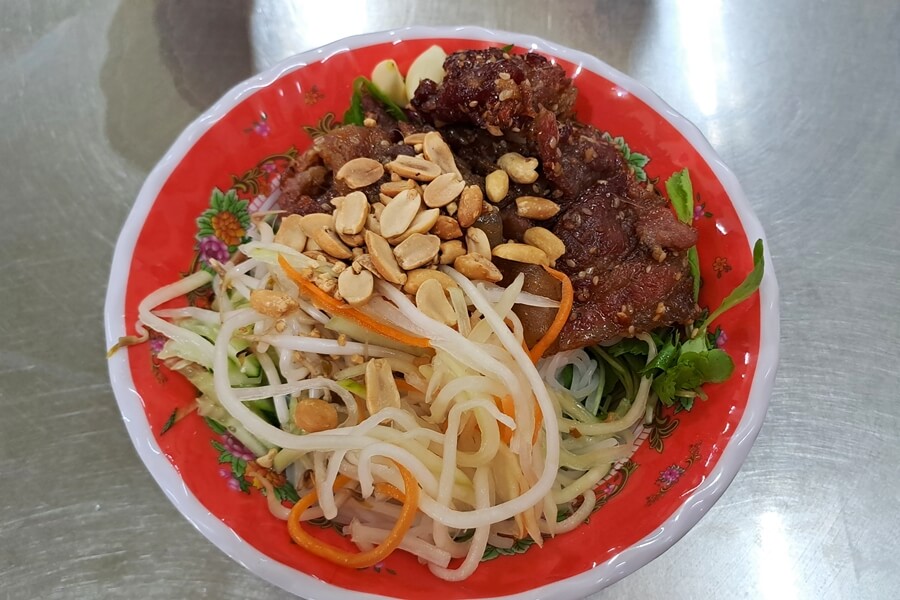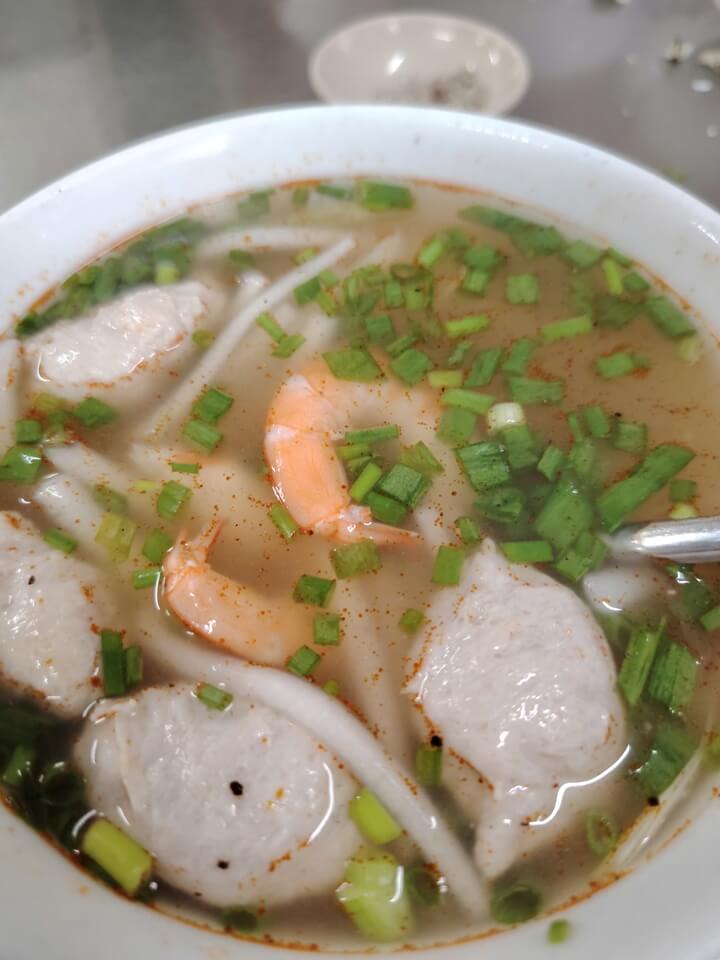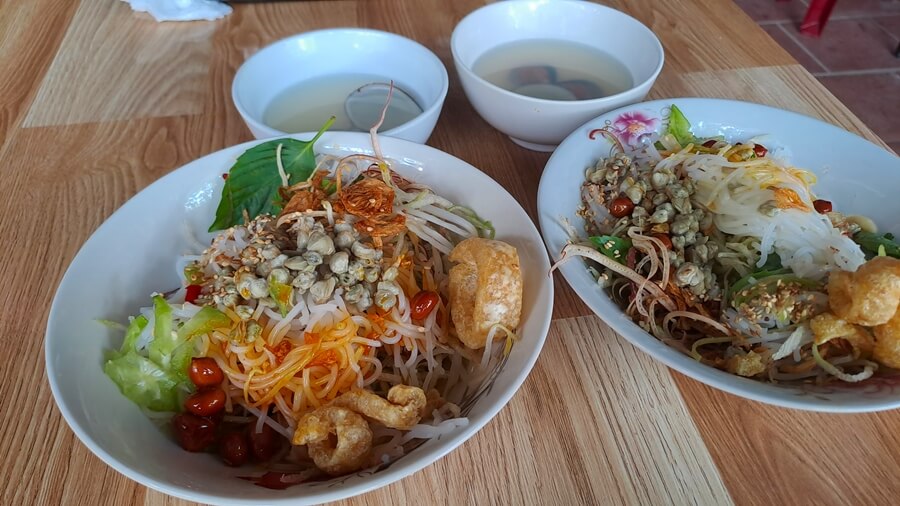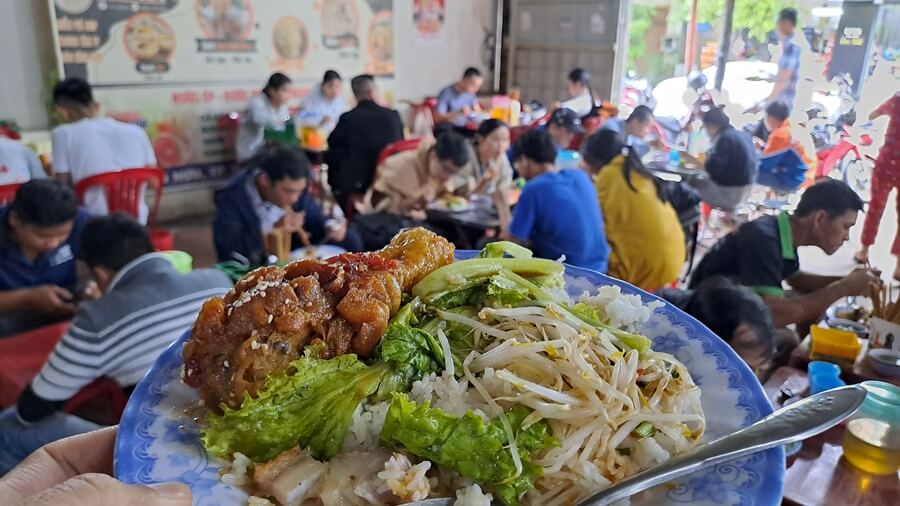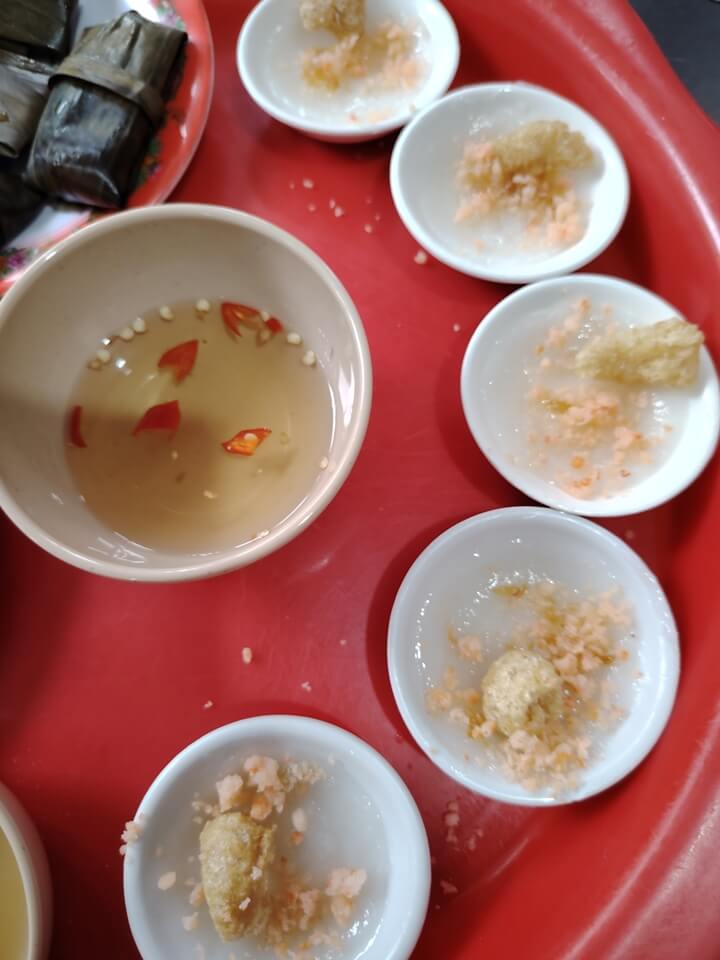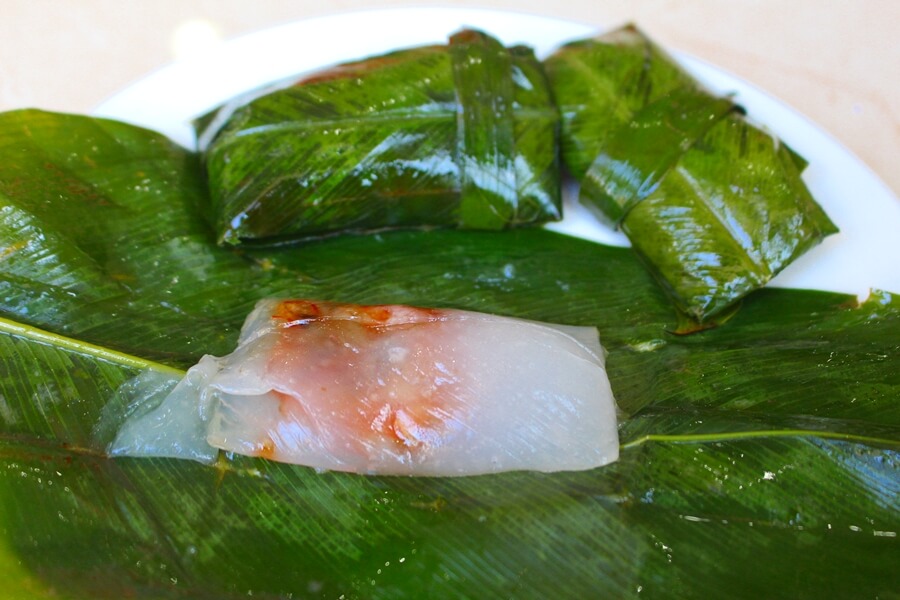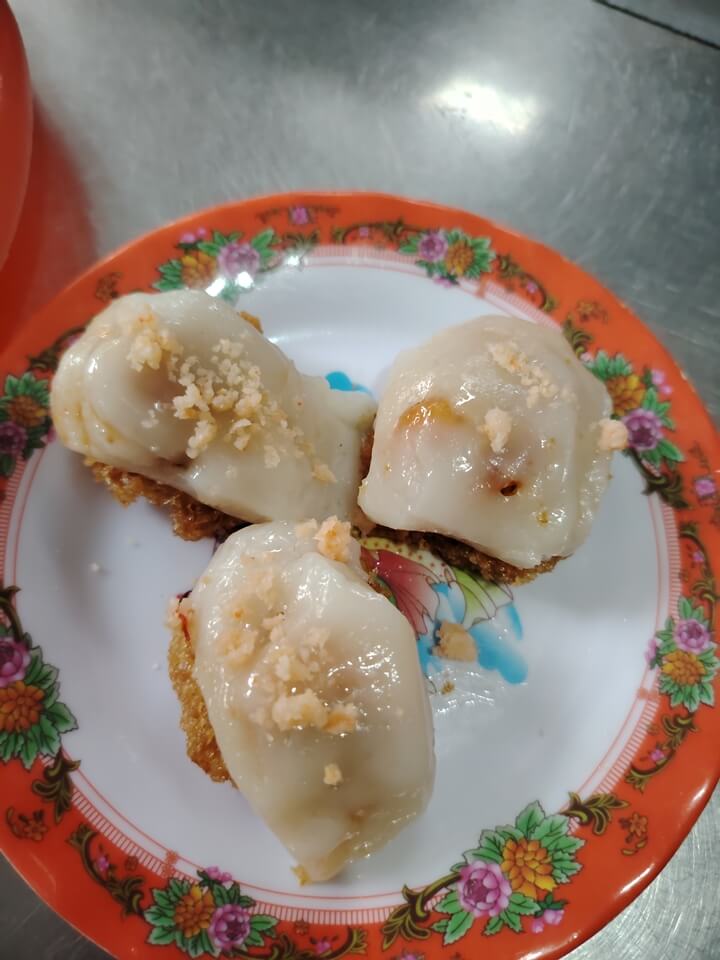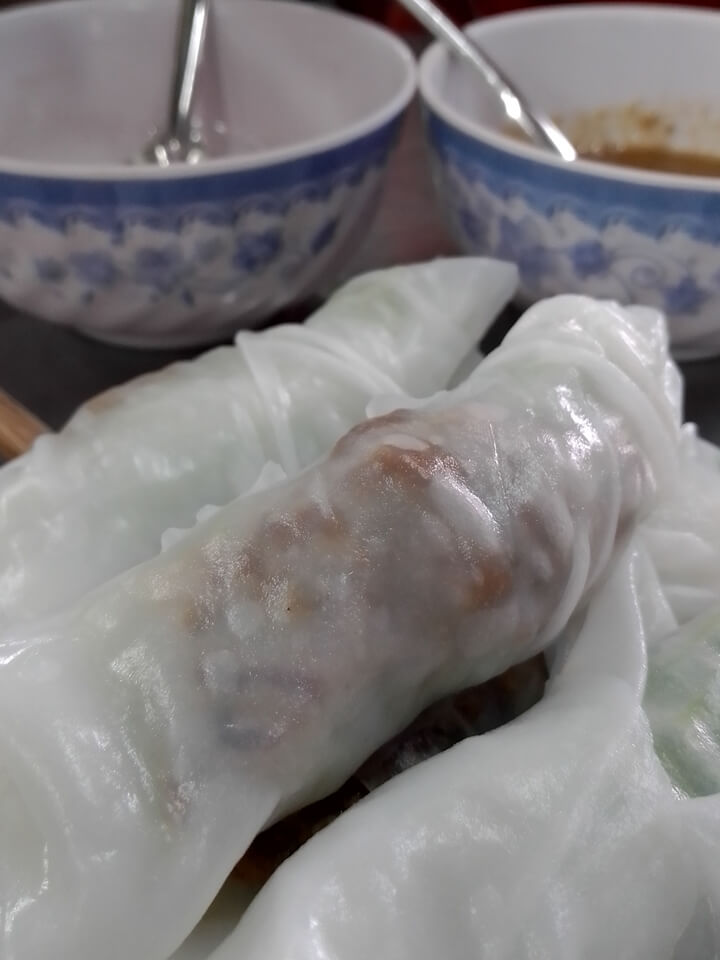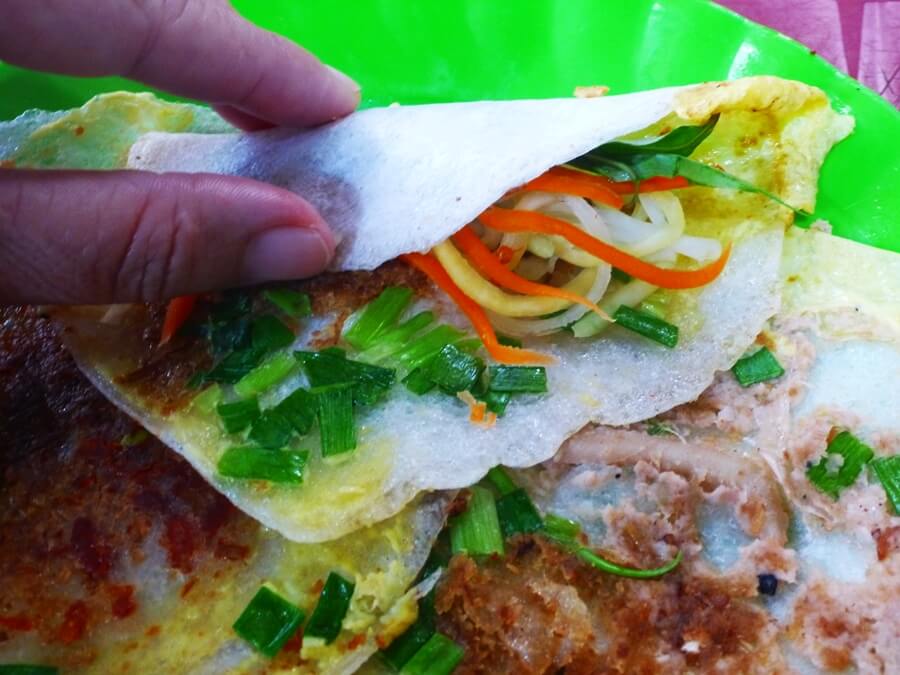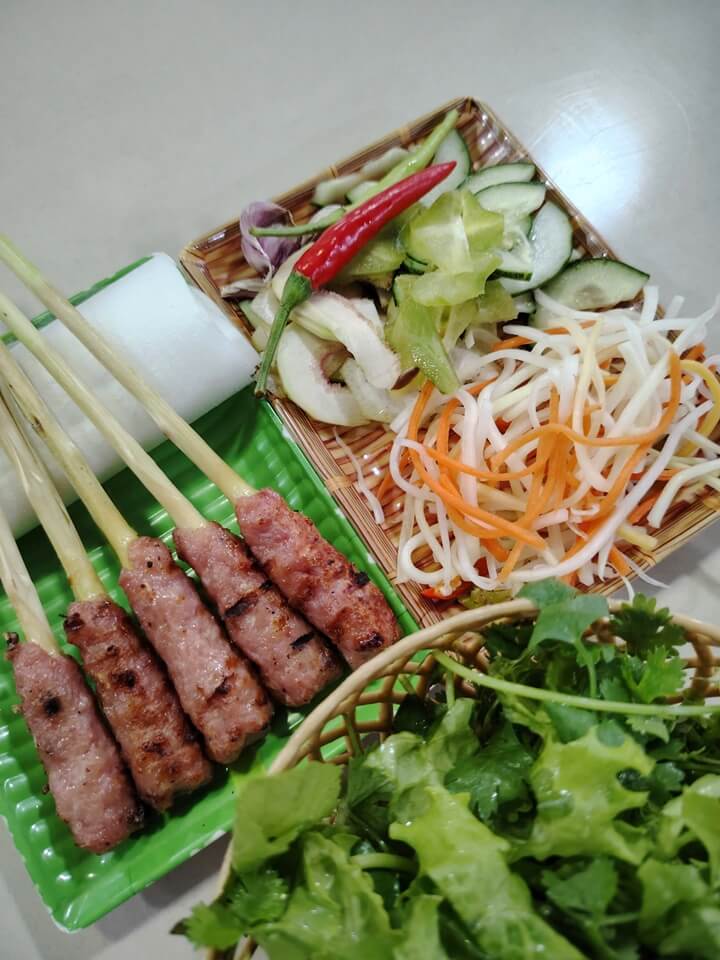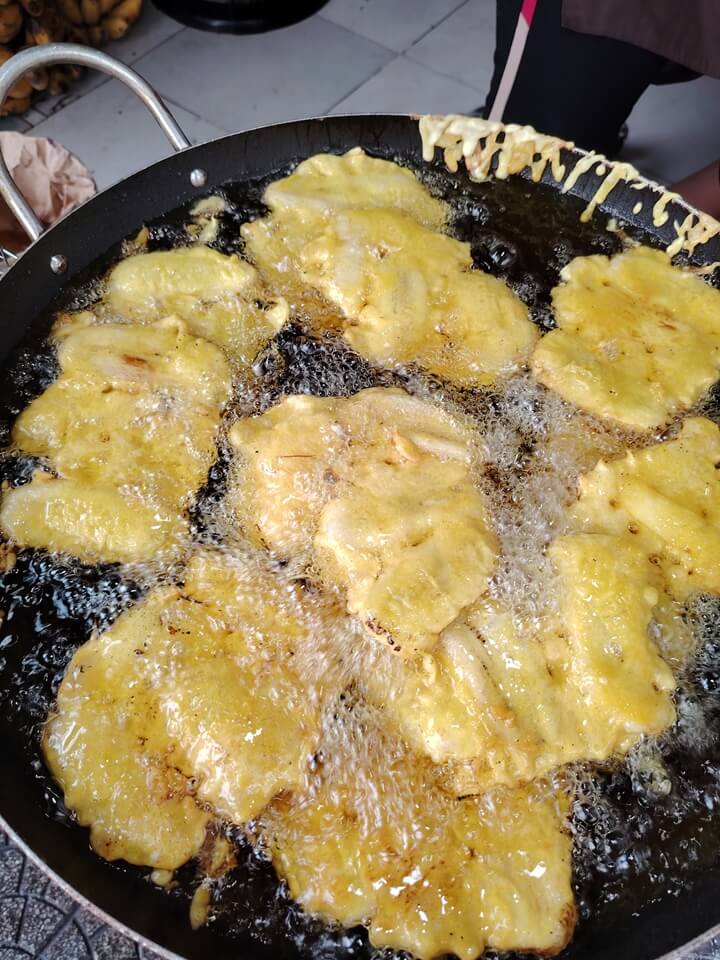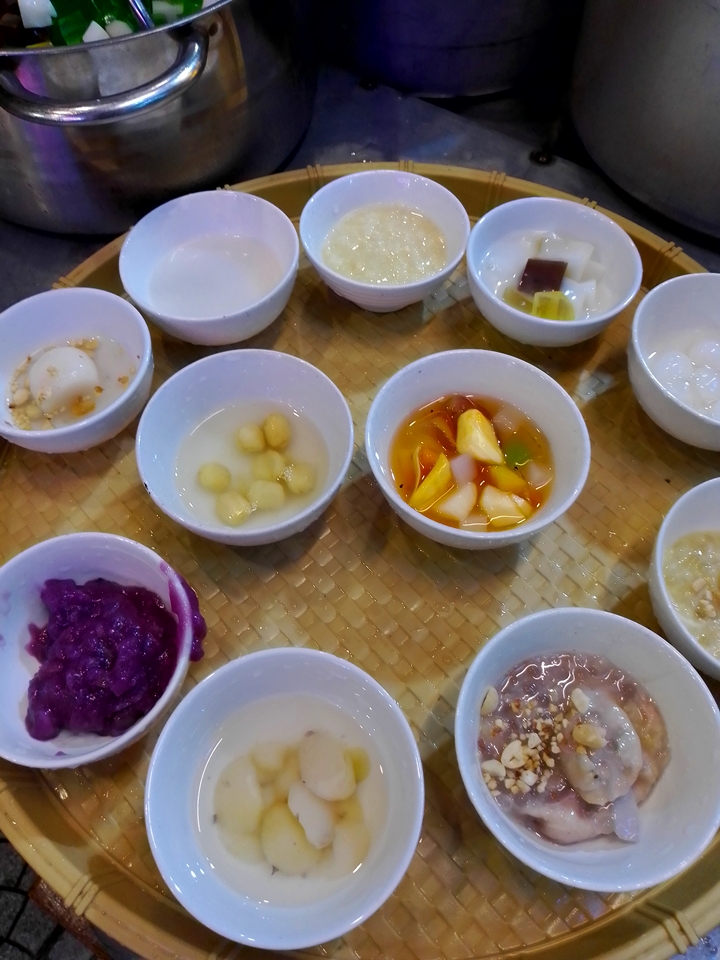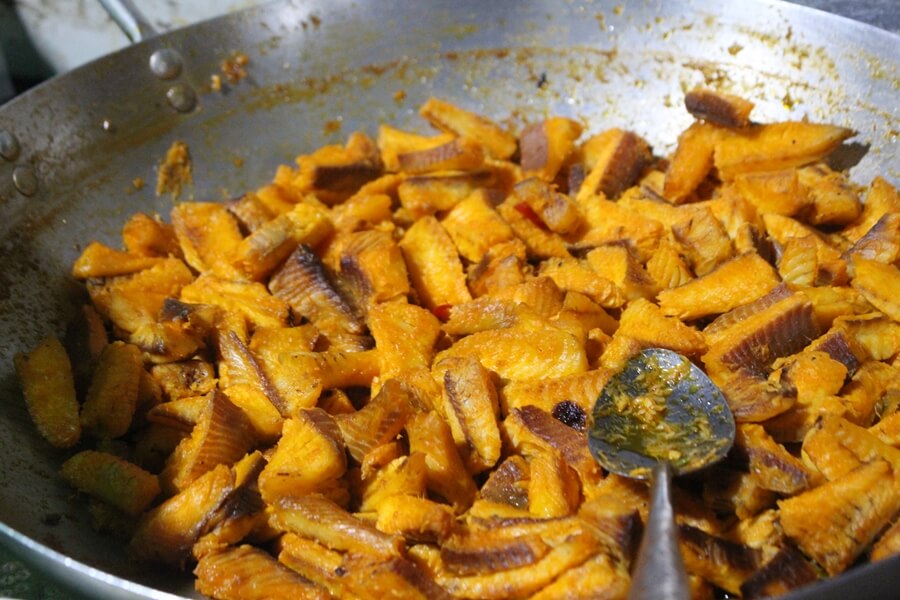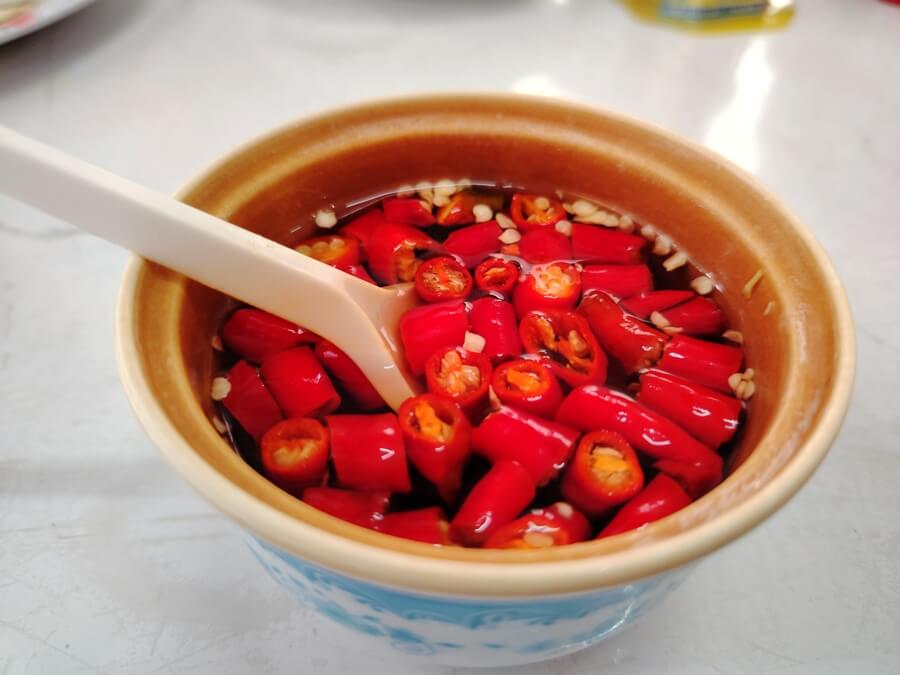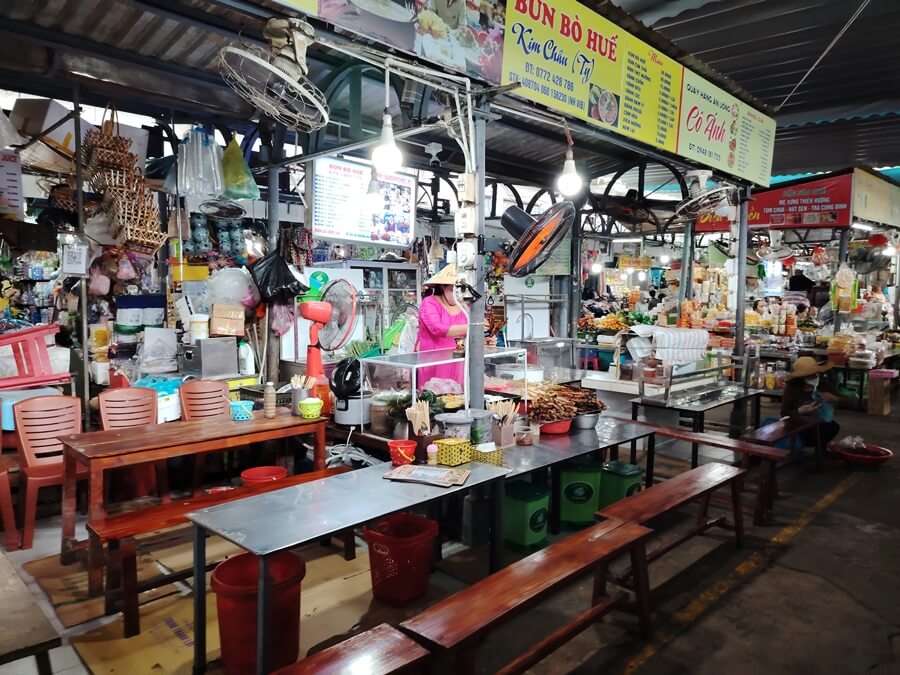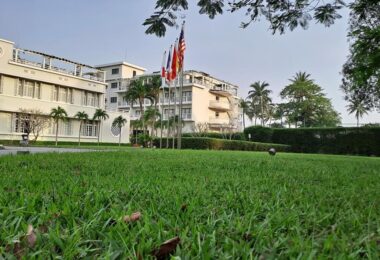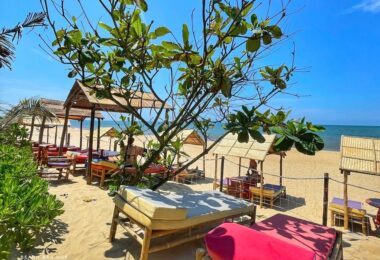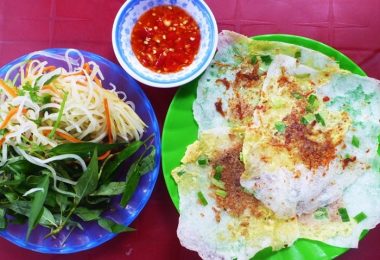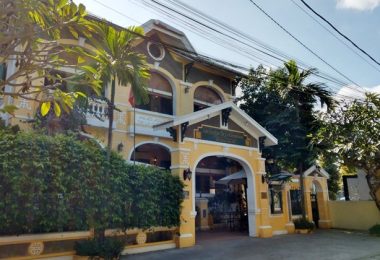For foodie, exploring local food in Hue is an exciting activity in this ancient capital of Vietnam during the last Nguyen dynasty, from 1802 to 11945.
Thanks to royal cuisine’s influence, the street foods in Hue have diverse colors and flavors that are hard to find in other cities.
Let’s check the must-tasted local dishes here!
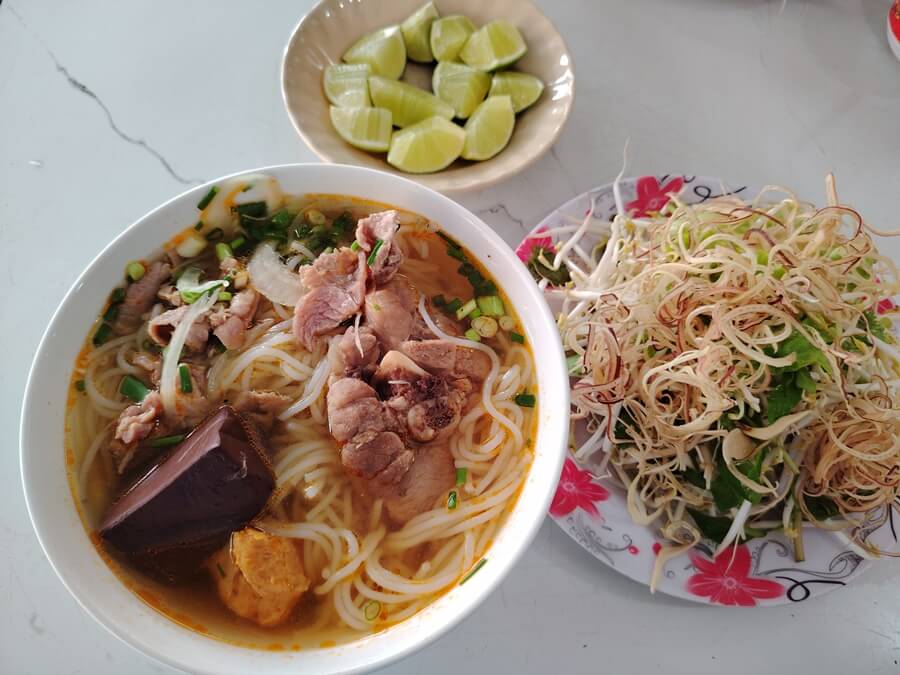
A. The Most Famous Local Foods in Hue City
There are hundreds of Hue dishes in daily life, and are sold from street food stalls to luxury restaurants.
These are the outstanding dishes that you can easily find in popular eateries and restaurants serving tourists in Hue city.
1. Iconic Noodle Dishes
1.1 Hue Beef Noodle Soup (Bún Bò Huế)

Hue beef noodle soup has become a popular daily dish for locals, especially for breakfast. Almost every street in this city sells them.
The dish is easy to eat because the broth is simmered from pork bone (o (optional with a bit of beef bone), with lemongrass, pineapple, a little shrimp paste, seasoning powder, fish sauce, onion, and pepper to increase its taste.
The bowl of noodles is served with a fragrant smell of lemongrass and a light scent of seafood from the shrimp paste. On top of the white noodles are a few pieces of sliced beef, pork leg, or pork belly—optional—a little crab cake and a piece of beef blood.
When eating, Hue people often add chili fish sauce, lemon, and raw vegetables, creating a balance of flavors: sour, spicy, salty, and sweet.
Where to Eat Hue Beef Noodle Soup:
- Bun Bo Hue Quan Cam: 45 Le Loi, Hue City
- Bun Bo Hue Ba Hoa 2: 7 Ha Noi, Hue City
- Bun Bo Hue: 19 Ly Thuong Kiet, Hue City
1.2 Snakehead Fish Noodle Soup (Bánh Canh Cá Lóc)
Ranked after Bún Bò, snakehead fish noodle soup is popular as a lunch and dinner dish. It is sold in small restaurants in Hue City or on the sidewalk.
The broth is made from snakehead fish heads and a small amount of pork bones, less than what is used in Bún Bò. A little shrimp paste enhances the broth for a light yet rich flavor.
The noodles are made from rice, tapioca, or wheat flour and cooked thoroughly before being served in a bowl.
The owner puts a little boiled snakehead fish meat, prepared in advance, on top of the noodles in the bowl, scoops the hot broth, and pours it evenly. Then, sprinkle a lot of spring onions on the bowl of noodles, making its surface sparkle with the light yellow color of fried chili.
The scent of green onions is light and fragrant. This unique noodle soup combines the river flavor of snakehead fish, the sea flavor of shrimp paste, and the spiciness of red chili soaked in fish sauce. This dish promises a different taste of noodles, and it is only available in Hue.
Where to eat Snakehead Fish Noodles:
- Thuy Snakehead Fish Noodles: Street No. 10 Vo Chi Cong, Hue City
- Hang Snakehead Fish Noodles Restaurant: 136 Ba Trieu, Hue City
1.3 Vermicelli with Grilled Pork (Bún Thịt Nướng)
This vermicelli dish is served dry, without broth, but with mixed peanut sauce and fish sauce. It is a Southern-style variation of grilled beef vermicelli, in which Hue chefs use grilled pork instead of beef.
The pork is carefully selected, with more lean meat and less fat, and marinated with galangal, sesame, a little honey, garlic, and sugar. Then, it is grilled over hot coals, creating an attractive aroma.
The golden meat, with a few black spots due to burning, adds a little sesame peanut broth, mixes well with raw vegetables from lettuce, herbs, bean sprouts, and banana flowers, and adds a few roasted peanuts to add a rich flavor.
Where to eat Vermicelli with Grilled Pork:
- Tai Phu Restaurant: 2 Dien Bien Phu, Hue City
- Huyen Anh Restaurant: 50 Kim Long, Hue City
1.4 Shrimp Noodle Soup (Bánh Canh Tôm)
This noodle dish is made from three types of flour: rice, tapioca, and wheat. Hue people often like shrimp noodles made from rice flour.
The flour is pre-mixed, and when a customer orders, the owner cuts it into small pieces of noodles, drops them into a big pot of boiling water, and cooks them for about 3 minutes.
Typically, just right when ordering a bowl, the waiter makes the noodles at that time, so the noodles feel fresh on each piece.
The noodles are placed in a bowl with a few peeled, golden-brown boiled shrimp and small pieces of pork sausage sprinkled with black pepper. The owner then evenly pours hot broth, simmered from pork and shrimp, over the noodles.
Diners often add more sliced spring onions, a little black pepper, and a little annatto-colored chili sauce, sparkling red, all over the bowl of noodles.
The sweetness from the stewed boiled shrimp water and added spices make it difficult for diners to leave any drop of broth.
Where to eat Shrimp Noodle Soup:
- Ba Doi Noodle Soup: 1B Duong Van An, Hue City
1.5 Stir-fried Vermicelli with Offal and Turmeric (Bún Lòng Xào Nghệ)
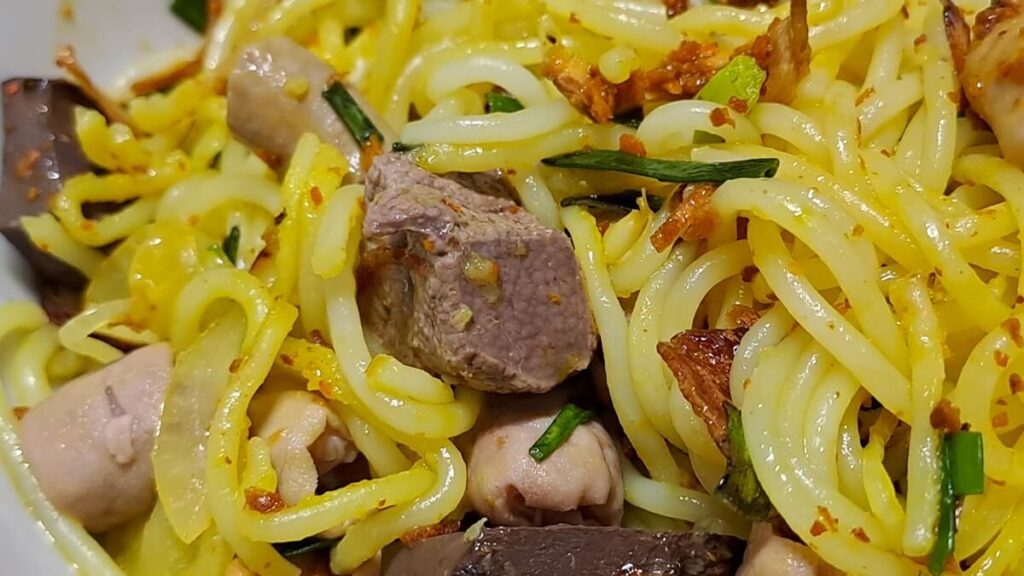
The rice vermicelli is mixed with yellow turmeric and stir-fried with cooked pig offal, including small intestine, pork liver, and blood cubes.
During the stir-frying process, the cook adds sliced spring onion, Vietnamese coriander, and fried onion to create a fragrant aroma that overpowers the smell of the offal.
This dish has a slightly spicy taste from turmeric, the fragrant aroma of pork liver and blood cubes, and the chewy texture of the small intestine.
Although stir-fried offal with turmeric is well-known to the locals, it is still unfamiliar to many international tourists because it is made from pork offal.
Where to eat Stir-fried Vermicelli with Offal and Turmeric:
- O Ket Turmeric Vermicelli Shop: 10 Alley 154 Ba Trieu, Hue City
1.6 Clam Vermicelli (Bún Hến)
Bun hen is a famous local food in Hue City because its variety of flavors and colors strongly attracts diners.
Many types of vegetables are served with bun hen, including star fruit, aromatic basil, coriander, and chopped taro stems.
A bowl of bun hen consists of the bottom part filled with all these types of vegetables, sliced white vermicelli on top, and a few spoons of mussels, chili sauce, fried shallot oil, and a few peanuts.
Diners can add shrimp paste, more chili sauce, and milky-colored clam soup with salt and pepper when eating.
A bowl of Clam Vermicelli is spicy, spongy from taro stems, fragrant with roasted peanuts, and sweet from clam soup. This combination creates a light feeling in this rustic dish.
Where to eat Clam Vermicelli:
- Ba Hoa Restaurant: 11A Truong Dinh, Hue City
2. Traditional Rice Dishes
2.1 Clam Rice (Cơm Hến)
Clam rice is as popular as Clam vermicelli (Bún Hến) because they are “siblings” of each other, with the same ingredients of vegetables and spices. Just change the vermicelli to cold rice.
There are many raw vegetables below, cold rice above, tiny clams, peanuts, dried shrimp, pork rinds, or pork skin. Add a little clam soup.
Many locals prefer vermicelli to rice because rice feels a bit separate, even though its taste is no different from vermicelli’s.
However, when trying the local dish here, Com Hen can create a strange feeling for tourists.
Where to eat Com Hen:
- Ba Hoa Restaurant: 11A Truong Dinh, Hue City
2.2 Hell Rice (Cơm Âm Phủ)
It has a rather strange name because of its old serving style. In the past, the restaurant only opened from 0:00 to 6:00 am, serving people who went out late or worked at night, so people called it Hell Rice.
Previously, the restaurant sold chicken porridge, shredded chicken, mixed rice, and stir-fried bamboo shoots. To meet the diverse needs of diners, the restaurant has added more dishes, such as spring rolls, grilled meat, vegetable soup, stir-fries, and braised fish.
At the same time, the restaurant also changed its hours to suit the new pace of life. It no longer sells from 0:00 to 6:00 am but opens for lunch and dinner from 9:30 am to 9:00 pm.
Where to eat Hell Rice:
- Hell Rice Restaurant: 51 Nguyen Thai Hoc, Hue City
2.3 Hue Dusty Rice (Cơm Bụi Huế)
The name is as interesting as the way it appears. In the past, street food stalls were often sold on sidewalks, where many people passed by so they could not avoid dust and smoke. From there, the name Dusty Rice (Cơm Bụi) was born.
Street food stalls are present throughout Vietnam, but in Hue, they are often concentrated in certain areas to serve students and low-income workers. These sidewalk stalls do not have to pay to rent a physical store; they only display a few small tables and chairs under a tarp to protect them from the sun and rain, so the price of a plate of rice is quite cheap.
Nowadays, street food stalls in Hue are no longer popular; most of them have moved into shops. However, they still cannot be called restaurants because the space is simple, with little decoration and simple tables and chairs to save maximum costs and keep the price of the food as low as possible.
Most dishes for street food stalls are prepared in advance, such as braised mackerel, grilled pork ribs, stir-fried water spinach, mixed vegetable soup, and stir-fried bamboo shoots. The preparation is intended to quickly serve the hungry stomachs of students and workers for lunch.
This is a popular dining style for locals. We want to introduce it to visitors so they can learn more about Hue’s culinary culture. Cơm Bụi is interesting because of its fast service, surprisingly cheap prices, and eye-catching food presentation. However, international tourists should consider carefully before experiencing Cơm Bụi. If you want to taste it, let’s try grilling pork ribs with rice.
Where to eat Cơm Bụi:
- O Hong Restaurant: 18 To Huu, City. Hue (Only open for lunch from 10 am to 2 pm)
- Chi Teo Restaurant: 59 Hai Ba Trung (10 am to 8:30 pm) – Neat, more diverse foods, better than the average rice stalls for students
3. Famous Dumplings and Pancakes in Hue City
Huedumplingsngs and pancakes are diverse, from street-style Bánh ép to royal-influenced Bánh khoái, each showing the skillfulness and elaborate preparation of the locals.
The most prominent cakes in Hue are Bánh bèo, Bánh nậm, Bánh lọc, and Ram ít. These dishes are often served together, so enjoying them in the same restaurant is easy.
3.1 Steamed Rice Dumplings (Bánh Bèo)
Steamed rice dumplings in Hue are steamed from rice flour mixed with a bit of tapioca starch in small bowls. The dumplings are thin, just enough for one bite. Sprinkle stirred shrimp, fried onions, and crispy pork skin.
Add a little sweet fish sauce cooked with sugar and chili when eating. The harmonious salty-sweet taste of the fish sauce, the toughness of the flour, and the crispiness of the pork rind create a richly textured feeling.
3.2 Flat Steamed Rice Dumplings (Bánh Nậm)
Hue’s flat steamed rice dumplings are thin and flat. They contain rice flour, minced pork, shrimp, a little seasoning, and green onions. The dumplings are then carefully wrapped in dong leaves and steamed for about 20 to 25 minutes.
Bánh nậm is usually kept in a sealed container and served while hot. To eat it, add a little fish sauce and a thin slice of chili, use a spoon to scoop lightly on the leaf surface, and put it in your mouth to enjoy.
If Bánh bèo feels the sweetness of the fish sauce and the lightness of the flour, then Bánh nậm is more flavorful and fragrant with dong leaves.
3.3 Tapioca Dumplings (Bánh Bột Lọc)
These dumplings use opaque tapioca flour, which turns transparent when steamed but is very chewy. They are wrapped in dong or banana leaves and are as small as two fingers, just enough for a bite.
In particular, each bánh lọc contains a shrimp fried with fish sauce and sugar – both salty and sweet. The shrimp is left in its shell to create a crispy texture inside the cake.
Bánh lọc has a chewy crust from tapioca flour. The shrimp filling inside is crispy and sweet, creating a funny feeling when enjoyed.
3.4 Sticky Rice Dumpling on Crispy Cake (Ram Ít)
Ram Ít is a harmonious combination of Bánh bèo, Bánh nậm, and Bánh Lọc. The crispy base is made from fried sticky rice flour; the filling has fried shrimp like Bánh lọc but smaller, and a little stirred shrimp-like Bánh bèo.
In particular, Ram Ít cake is made from sticky rice flour, which has a chewy texture and is slightly sweetened with sugar. It may seem like an unusual combination—the sweetness of the sticky rice flour exterior and the savory filling of fried shrimp—but this contrast is a perfect example of a Hue chef’s creativity.
Places to eat these dumplings:
- Banh Beo Ba Do Restaurant: 8 Nguyen Binh Khiem, Hue City
- Quan Huong: 37 Alley 177 Phan Dinh Phung, Hue City
- Hang Me Restaurant: 12 Vo Thi Sau, Hue City
3.5 Meat rolls (Bánh Cuốn)
Simple ingredients—wet rice paper rolled with grilled pork marinated in spices and a few sprigs of basil—are enough to create a meat roll dish with the flavor of Hue.
Meat rolls are often served in restaurants that also serve grilled pork vermicelli. This may be because the grilled meat of the vermicelli dish and meat rolls is similar, marinated with sesame, galangal, sugar, shrimp paste, and fish sauce.
A delicious taste of meat rolls dipped in mixed sauce (nước lèo), or sweet and sour fish sauce will be a helpful appetizer while waiting for the main dish.
Where to eat meat rolls:
- Tai Phu Restaurant: 2 Dien Bien Phu, Hue City
- Huyen Anh Restaurant: 50 Kim Long, Hue City
3.6 Crispy Pancake (Bánh Khoái)
Bánh khoái is considered the “queen” of pancakes in Hue. This dish is made from carefully selected ingredients: delicious rice flour and corn for the crispy base. The peeled and boiled shrimp, quail eggs, sausage, lean pork, and bean sprouts are used for the filling.
At first glance, many people mistake Bánh khoái for Bánh xèo. In fact, Bánh khoái is smaller, the base is crispier, and the filling ingredients are more diverse.
The dipping sauce served with Bánh khoái is a mixed sauce (nước lèo), which differs from the sweet and sour fish sauce of Bánh xèo. In addition, Bánh xèo can be rolled with raw vegetables, but Bánh khoái cannot because the base is thicker.
Where to eat Bánh khoái:
- Lac Thien Restaurant: 6 Dinh Tien Hoang, Hue City
- Hong Mai Restaurant: 110 Dinh Tien Hoang, Hue City
3.7 Pressed Cake (Bánh Ép)
On the list of street foods in Hue, Bánh ép (Pressed Cake) must be included. It is made from tapioca flour pressed tightly in a metal mold heated over hot coals.
When pressing, the chef adds a little scallion oil and quail eggs to enhance the fragrant and fatty flavor of this unique cake.
Pressed cakes are chewy when eaten fresh and crispy when eaten dry. Another interesting thing about these cakes is that they often make you sniffle because you dip them in chili fish sauce or spicy chili sauce when eating them.
Where to eat Pressed Cakes:
- Gia Di Restaurant: 4 Phung Chi Kien, Hue City
- Banh Ep Trang Restaurant: 3 Le Viet Luong, Hue City
4. Grilled & Fried Dishes in Hue City
4.1 Pork Skewers (Nem Lụi)
Pork skewers have become a famous local food in Hue City, giving a fragrant water-mouth taste to many tourists.
Nem Lụi is made from minced pork, onions, garlic, and spices fermented for 2-3 hours. The chef then squeezes the pork onto lemongrass stalks or bamboo chopsticks and grills them to serve diners.
Nem Lụi is served with raw vegetables wrapped in thin rice paper and dipped in a broth with peanuts, sesame, soybeans, pork liver, and shrimp paste.
The aroma of this pork skewer, the rich flavor of its mixed sauce, and the freshness of the raw vegetables make this a dish worth sharing with friends.
Where to eat the pork skewers:
- Hong Mai Restaurant: 110 Dinh Tieng Hoang, Hue City
- Tai Phu Restaurant: 2 Dien Bien Phu, Hue City
4.2 Fried Bananas (Chuối Chiên)
Fried bananas are a popular street food snack in Hue. They are made from ripe bananas, which are peeled, sliced , or flattened, then dipped in a thick flour mixture and fried in hot oil.
The fried banana is golden yellow and fragrant, with a crispy crust covering the soft, sweet banana filling. This food is usually sold from 3 to 6 pm.
Where to eat fried banana cakes:
- Fried banana shop: 106 Nguyen Sinh Cung, Hue City
5. Sweet Treats
5.1 Hue Sweet Soup (Chè Huế)
Sweet soup is a popular dessert throughout Vietnam on hot days. Hue sweet soup is also eaten on sunny and cold days.
Hue sweet soup is also notable for its variety. A typical sweet soup shop offers around 20 different types. In contrast, sweet soup stalls in other places usually serve only one or a few varieties.
Chè Huế uses various ingredients, from red, green, and royal beans to tapioca flour, roasted pork, and fruit.
The sweet, refreshing taste is a dessert not to be missed here, sold from morning to night. When eating, you can add more ice and drink simultaneously on hot days; eat less ice or no ice on cold winter days.
Where to eat Hue sweet soup:
- Hem sweet soup: 1 Alley 29 Hung Vuong, Hue City
- Cam sweet soup: 10 Nguyen Sinh Cung, Hue City
- Ngoc Hien sweet soup: 67 Tran Hung Dao, Hue City
B. Local Food Culture & Eating Tips in Hue City
Hue cuisine is enriched by the combination of royal style and local characteristics, creating unique ways of preparation, enjoyment, and flavor.
From there, the Hue people developed a sophisticated and meticulous cooking style for each dish, focusing on the balance of spices.
The serving style for local food in Hue also bears a royal stamp. Many dishes are presented on small plates, and each portion is just enough to taste one bite.
For example:
- Bánh bèo: It is only ¼ the size of Hoi An Bánh bèo, and the filling contains many different ingredients.
- Bánh khoái: The size is significantly smaller than Saigon Bánh xèo, but the filling is complete.
- Peacock rolls and phoenix meat rolls (Nem công, chả phụng): These dishes are elaborately prepared and presented in the shape of peacocks and phoenixes. Currently, only a few luxury restaurants in Hue serve them.
Then, we can summarize the cuisine culture and eating style of Hue food below:
Royal style to enjoy
Hue people’s eating style is influenced by the royal style, which involves eating few but many dishes. For example, dumplings in Hue City are not something you can eat to be full, but they are a form of food to eat for fun.
Balance in flavor
The blend of spices creates balance in Hue people’s local dishes, with sour, spicy, salty, and sweet tastes. This helps Hue cuisine become more prosperous than other regions.
At the same time, the seasoning technique, the way to marinate the ingredients before preparing the dish, is meticulously done in each step to ensure a delicate balance of flavor for each dish.
Eating spicy food
Perhaps because of their unique taste, the locals often like spicy food, so chili is added to almost all dishes in Hue City. When you order food, you should ask the chef to make the dish less spicy if you cannot eat spicy food.
The contrast between royal and ordinary people
Although the royal dining style is quite sophisticated and polite, on the contrary, street food and small eateries in Hue have a comfortable and close feeling.
There is no distinction between the rich and the poor, manual workers or office workers. Everyone can sit and eat together comfortably and drink at the same cafe. That creates the incredible attraction of Hue’s culinary culture and the people here.
Using chopsticks in Hue meals
Like anywhere in Vietnam, Hue people often use chopsticks; you rarely see forks on the dining table. If you cannot use chopsticks, ask the server for an extra fork; they will happily serve you if they have one.
C. FAQs about local food in Hue City
What are the most famous local dishes in Hue?
The most famous dishes in Hue City are beef vermicelli doup (Bún Bò), crispy pancakes (Bánh Khoái), and pork skewers (Nem Lụi).
However, for young students, pressed cakes (Bánh Ép) are considered the top snack choice because they are affordable and have the spicy flavor of the dipping sauce, which many friends can enjoy together.
When is beef vermicelli soup eaten, and how much does it cost?
Beef vermicelli soup is often eaten for breakfast all over the streets of Hue. Small restaurants serve a bowl of beef vermicelli for between 25,000 VND and 55,000 VND. The price depends on the quality and size of the bowl.
Although bun bo Hue is usually served in the morning, some restaurants serve it at noon or evening. Therefore, you can easily find this food in Hue at any time of the day when coming to this city.
What should I pay attention to when I am allergic to seafood?
Hue people habitually use shrimp paste in most dishes to enhance the flavor. So, when you are allergic to seafood, you must pay attention to this issue.
Should I enjoy Hue’s local food in the market?
The market is a place to explore Vietnam’s unique culture and cuisine. However, because local markets preserve food and serve dishes quite simply, international tourists should think carefully before eating at local markets in Hue.
D. Conclusion
Enjoying local food in Hue City should be at the top of your list of activities for your trip here.
The cuisine in Hue blends popular and royal styles, creating a diverse dining experience in terms of processing, eating, and flavor.
If your time is limited but you still want to explore the local cuisine, join our Hue food tour. This is a quick and convenient way to enjoy the typical flavors of the ancient capital.


